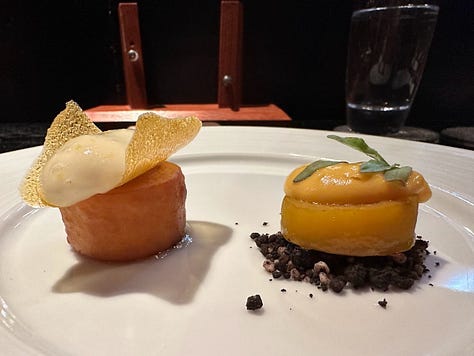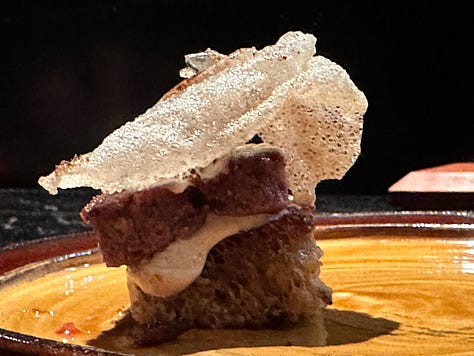Bulrush: A Food-only Review









I would love to write you a detailed description of the uniqueness of experience surrounding dining at Bulrush. I’m honestly dying to set the scene around the exhibition art in the bathroom, the historical wall projections on Ozark cuisine, and the intriguing vibe-shift from bar to dining room. Most interestingly, I’d love to explain Chef Rob’s ideas around “reparative restauranting,” and the projects Bulrush supports towards that effort. But I won’t. Because this is a food-only review.
Even though Bulrush, has a one-to-one food to experience ratio, and it’s killing me to leave out half of what makes this restaurant what it is, I’ve committed myself to helping you decide whether you’d like to go based SOLELY on the flavors offered. And buckle-in, because besides the 7 (YES, SEVEN) mystery courses you agree to receive by pre-purchase at the time of your reservation, Chef Rob Connoley also includes a welcome drink, a “staff idea” bonus course, and a gift as you exit “for Breakfast tomorrow.” Each of these courses will be described, in hopes of piquing your curiosity, and not ruining any of the surprise.
Upon entry, you are greeted by a bartender who says he’s been working on something to “warm you up” and ladles a mug full of “welcome drink.” It is hot, of course, but also overtly orange, complicated, and has a bitter finish. As he describes the drink, only a few ingredients stick: tangerine kombucha, fennel, mulled spices, beets. He walks you and your drink to your seat where your server knows your name, offers you expanding hand-wipes (which I will not describe, because they are not food…) and promptly serves you the first course.
This course is served on a silver tasting spoon and is not recognizable. It’s exactly what you hope for in a fine-dining experience: bright colored speckling on white foam, next to gel of some sort, with a thick crust-like bottom. Chef describes while you look and try to compute the description of the mulberry mochi, fennel orange kombucha raindrop cake, and kinako (kina-what?) with your visual understanding of the 2-bite curiosity. Once you taste, this mouthful of crazy is layers of contrasting textures. The bottom layer and middle jelly are reminiscent of the Fig Newton, but the sour of the mulberry and kombucha foam stand out against the sweetness. The 2nd bite helps you understand the first, though both bites are different experiences: this spoonful is not symmetrical.
Next, Chef presents 2 layered beet-based cylinders. They are described succinctly but you mostly question the words used, like pringle and bull’s blood. Pringle, it turns out, only refers to the shape of the lacey crisp holding the citrus flavored foam (pictured on the left.) Bull’s blood is the name of the micro-greens on top of the beet custard (pictured on the right.) The cylinder on the right is beet in the way you understand it: earthy, slick, with a hint of sweetness at the end. It is sitting on what looks like, tastes like, but you are sure couldn’t be, a bed of crumbled Oreos. The chef eventually tells you this is “Cocoa soil.” The cylinder on the left has a fried polenta feel and taste, but Chef says it’s a Beet Panisse. It has a creamy mush interior with a lightly crisped (maybe fried?) shell. The cylinders are taste nothing alike, despite being based in beet.
Course 3 is a “Venison Torchon.” If you speak French, but are not a chef, you may wonder what a towel (torchon’s translation) has to do with deer meat. However, you are familiar with certain parts of this dish: Grilled Rye and goat cheese are mentioned, plus a fried shallot. The dish, as is becoming the norm, is a surprise as compared to its description. The top layer is a caramelized flake that holds fantastic crunch and trace onion flavor. Next is the venison, which holds a dried meatloaf texture, but is less heavy than beef, and slightly grainy. Below that sits the sharp goat cheese mousse, and finally a clove and pepper flavored kick of grilled rye bread at the bottom. Each of these holds an equal place in the tasting process; no single layer dominates.
The next course, a walleye and pork dumpling, with Ozark chili crisp (Ozark chilis?!?), served in a consommé, is the first dish to come out as you imagined! The fish and pork dumpling combination is something you understand: the filling is dense; the noodle is thick and sticky; it does not overwhelm with flavor. However, the broth is not anything you’ve had at your favorite Asian restaurant. The chili spice dominates, and there is a harder, tan colored crunchy offering providing a mostly salty, sometimes sweet, contrast. Is this thing peanut based? Maybe garlic is involved? Neither seems right as you taste. Chef explains it is catfish crackling and candy roaster squash, which sort of helps, and you enjoy each bite, grateful the dumplings come in pairs.
Each course begins with new flatware, and I’d really love to talk about the spork that preceded this next course. I took six pictures of it. But it isn’t food. So you’ll have to dream about that one until you go. I’m honestly not sure the spork was necessary for the sweet potato hash brown with garlic cream foam, and flowery yeast crisp that sat on top, but I certainly enjoyed discerning how to best use it. This dish does have a “mashed potatoes and gravy” level comfort, but the crisp makes it completely new. It is a different texture, of course, yet past the wheat and yeast flavors, there is a finishing flavor that Chef credits as soybean flour, and a top sprinkling of radish powder.
Course 6 actually doesn’t count as a course. It is labeled “Staff ideas” and changes week to week. This dish is not required to be rooted in Ozark ingredients, and is intended to represent new ideas that the menu could move towards in the future. Tonight’s offering is what you might call a ravioli, but chef explained is a mezzaluna (half-moon, in Italian). It is filled with beet ricotta and bison sausage. You may not remember the sausage, because this creamy, dreamy ricotta filling is the hero. The dish is dressed in only Amish butter which allows the saffron and paprika in the pasta to lead.
The actual 6th course is what you might call the main attraction. It is pork belly on polenta with collard greens, a bordelaise sauce, and turnip. The main surprise here is that the polenta is creamed “sauercorn,” (think sauerkraut with corn rather than cabbage) and is it purple! As with the other dishes, the balance is perfection. The pork belly is fatty; the polenta is acidic; the bordelaise is salty; all the foods are transformed by heat, with one exception: the turnip. This hilarious lonely side root vegetable is the ultimate contrast. It sits, cold, and nearly flavorless, ready to help reset your palate when necessary. While it is less food than your traditional main course, this dish is significantly larger than all the rest.
Finally, you are served dessert: a pawpaw butterscotch Cremieux, wrapped in a hazelnut mousse pinecone. Its partner is a mini-gingerbread loaf with a maple leaf tuile. The Ozark theme is visually shining here. The pinecone is soft and nutty, as expected, but the pawpaw cream in the center is a surprise! (You will learn more about pawpaw if you go.) The whole pinecone is held standing with a dark chocolate base, melted to attach it to its glass serving box. On the edges of the pinecone are a few squares of pine infused gelée which are tangy, not earthy or Christmas-y, as you might expect. The gingerbread is warm, and spicier than any gingerbread you’ve made. Its leaf décor is a wafer-like cookie with enjoyable crispness. Both offerings are sweet, but not distractingly so, and complement each other in contrasting temperature, texture, and taste.
As Chef thanks you for coming he hands you a little present: a boxed pastry for tomorrow. He describes it as his take on a gooey butter cake, with acorn. You are also handed an envelope with the evening’s foods described, and two other surprises, that are not food, and I will leave to your imagination. You leave with tastebuds engaged, and wondering how this curated experience can be repeated night after night.
Candidly, I didn’t find any of this (save maybe the dumplings) to be overwhelmingly delicious. The fine-dining experience, for me, is rarely the dopamine release that comfort or indulgence foods can be. However, this dining is the kind of fun that makes you parse and consider and discern. And if you are excited by the idea that the food I’ve just described is only half the fun, you should certainly make your way to Bulrush to take in the full experience for yourself.



